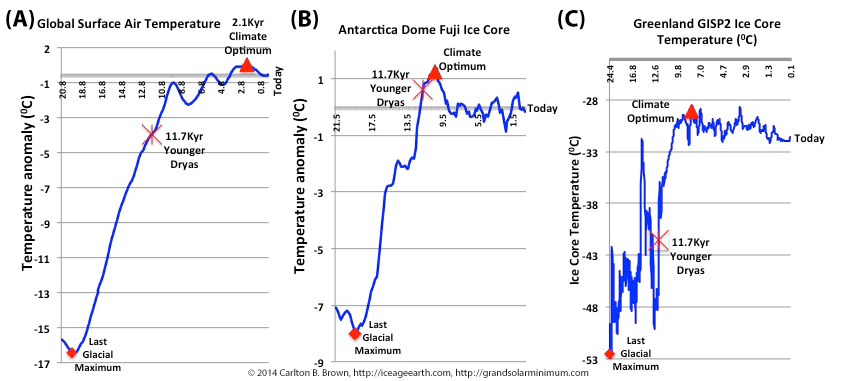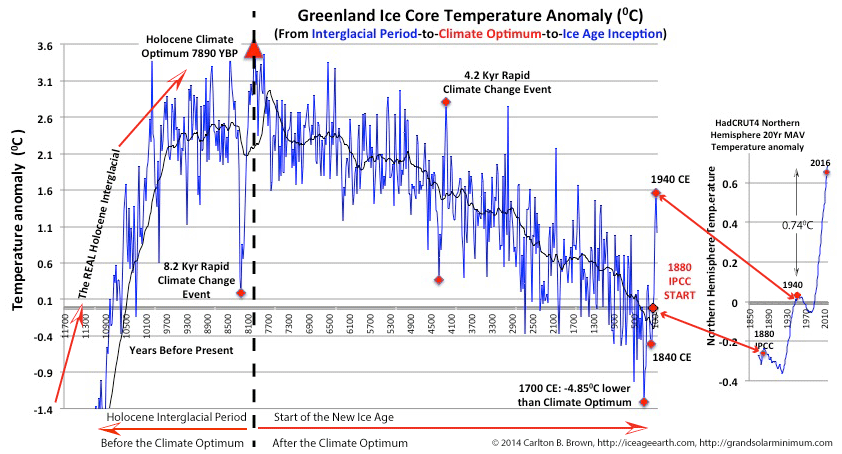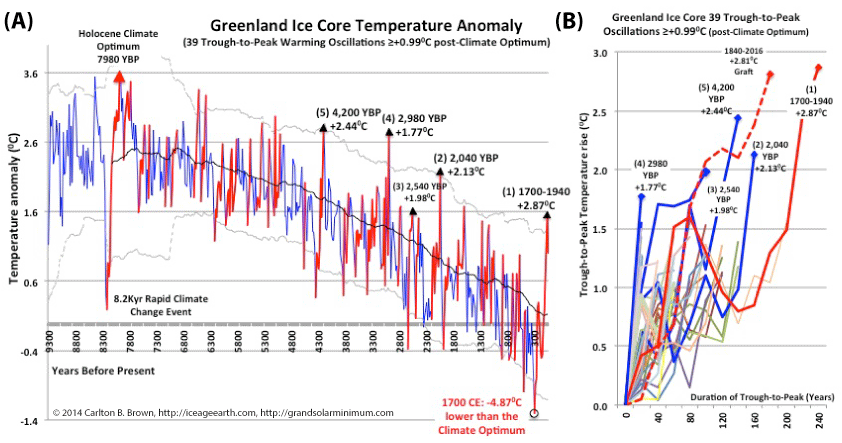
The Last Ice Age Ended 20,000–24,000 Years Ago, Not 11,700 Years Ago
We are told by science and in our schools that the last ice age (glacial period) ended 11,700 years ago, after which the Holocene interglacial began. However, the reality is this timing actually coincided with the end of the Younger Dryas, or a period that represented the worst rapid climate change event since the last glacial maximum 19,600 years ago (global data).
Figure legend: Reconstructed global,[i] Antarctic,[ii] and Arctic[iii] glacial cycle temperatures from the last glacial maximum or end of the last ice age (lowest temperature, red diamond shape) to just past the climate optimum at the end of the interglacial period (highest temperature) delineate three points of reference i.e., the last glacial maximum, the end of the Younger Dryas 11,700 years ago, and the Holocene Climate Optimum (red triangle shape). The glacial maxima and the climate optima are at either end of the interglacial period. The supposed end of the last ice age 11,700 years ago (11.7 kiloyear) is marked above. If the ice age ended 11,700 years ago then the 11.7 kiloyear marker should be close to the glacial maximum marker at the bottom of the graphics, but this is not the case.
Prior to the end of the Younger Dryas 11,700 years ago, and within the space of a few decades, the temperature in the Arctic dropped by about nine degrees Celsius.[i] The temperature did not recover for another three hundred years. During this time the Arctic ice sheets advanced and the most pronounced fauna extinctions of the Holocene interglacial took place, including dozens of mammalian and avian species.[ii],[iii]
Climate data reconstructions show that the lowest temperature at the last glacial maximum in Greenland (GISP2 ice core)[iv] occurred 24,098 years ago, in Antarctica at Dome Fuji 19,300 years ago,[v] and globally the lowest temperature occurred 19,600 years ago.[vi] The Antarctica Dome-C[vii] and Greenland Ice Core Project (GRIP)[viii] climate data reveal similar glacial maximum and climate optimum timelines to those displayed in the figure above. The correct date for the last glacial maximum (i.e., end of the last ice age) can be seen in the figure above relative to the 11,700-year date for the end of the Younger Dryas.
By the end of the Younger Dryas 11,700 years ago, when the current Holocene interglacial had “officially” started (as we are told), nearly two-thirds of the Holocene’s total sea level rise, and three-quarters of the Holocene’s total temperature rise had already taken place (see table summary in the citation).[ix] Therefore, equating the end of the Younger Dryas with the end of the last ice age means we are in error as to the correct stage of the glacial cycle that we are in now.
[i] A.E. Carlson, 2013, “The Younger Dryas Climate Event.” In: Elias S.A. (ed.) The Encyclopedia of Quaternary Science, Volume 3, 126-134. Amsterdam: Elsevier. http://people.oregonstate.edu/~carlsand/carlson_encyclopedia_Quat_2013_YD.pdf.
[ii] Anthony D. Barnosky et al., “Approaching a state shift in Earth’s biosphere.” Nature Volume 486, 52–58 (07 June 2012). doi:10.1038/nature11018. .
[iii] R. B. Firestone et al., “Evidence for an extraterrestrial impact 12,900 years ago that contributed to the megafaunal extinctions and the Younger Dryas cooling.” PNAS October 9, 2007. 104 (41) 16016-16021; https://doi.org/10.1073/pnas.0706977104.
[iv] R.B. Alley, 2004, “GISP2 Ice Core Temperature and Accumulation Data.” National Centers for Environmental Information, NESDIS, NOAA, U.S. Department of Commerce. https://www.ncdc.noaa.gov/paleo/study/2475. Downloaded 05/05/2018.
[v] R.V. Uemura et al., 2012, “Ranges of moisture-source temperature estimated from Antarctic ice cores stable isotope records over glacial-interglacial cycles.” Climate of the Past, 8, 1109-1125. doi: 10.5194/cp-8-1109-2012. National Centers for Environmental Information, NESDIS, NOAA, U.S. Department of Commerce. Dome Fuji 360KYr Stable Isotope Data and Temperature Reconstruction. https://www.ncdc.noaa.gov/paleo-search/study/13121. Downloaded 05/05/2018.
[vi] Bintanja, R. and R.S.W. van de Wal, “North American ice-sheet dynamics and the onset of 100,000-year glacial cycles.” Nature, Volume 454, 869-872, 14 August 2008. doi:10.1038/nature07158. National Centers for Environmental Information, NESDIS, NOAA, U.S. Department of Commerce. Global 3Ma Temperature, Sea Level, and Ice Volume Reconstructions. https://www.ncdc.noaa.gov/paleo-search/study/11933. Downloaded 10/27/2015.
[vii] J. V. Jouzel et al., 2007, “Orbital and Millennial Antarctic Climate Variability over the Past 800,000 Years.” Science, Volume 317, No. 5839, 793-797, 10 August 2007. National Centers for Environmental Information, NESDIS, NOAA, U.S. Department of Commerce. EPICA Dome C – 800KYr Deuterium Data and Temperature Estimates. https://www.ncdc.noaa.gov/paleo/study/6080. Download data: Downloaded 08/02/2016.
[viii] Sigfus J. Johnsen et al., 1997, “The d18O record along the Greenland Ice Core Project deep ice core and the problem of possible Eemian climatic instability.” Journal of Geophysical Research: Oceans, 102(C12), 26397-26410. doi: 10.1029/97JC00167. National Centers for Environmental Information, NESDIS, NOAA, U.S. Department of Commerce. GRIP Ice Core 248KYr Oxygen Isotope Data. https://www.ncdc.noaa.gov/paleo-search/study/17839.
[ix] Data: R. Bintanja and R.S.W. van de Wal, “North American ice-sheet dynamics and the onset of 100,000-year glacial cycles.” Nature, Volume 454, 869-872, 14 August 2008. doi:10.1038/nature07158. National Centers for Environmental Information, NESDIS, NOAA, U.S. Department of Commerce. Global 3Ma Temperature, Sea Level, and Ice Volume Reconstructions. https://www.ncdc.noaa.gov/paleo-search/study/11933. Downloaded 10/27/2015. Personal Research: Using the above-cited file, the temperature and sea level data were extracted; from the Last glacial maximum 19,600 years ago to the Holocene Climate Optimum (2,100 years ago). The Younger Dryas 11,700 years ago was included to help us see that the last ice age did not end 11,700 years ago. Results: by 11,700 years ago the sea level had already risen 64% and the temperature 76% of their total Holocene interglacial rise (from glacial maximum to climate optimum). This confirms the last ice age did not end 11,700 years ago, but rather it was the Younger Dryas that ended. The data very clearly tells us the last ice age ended 19,600 years ago, after which the sea level began to rise and the ice mass decrease.].






Recent Comments